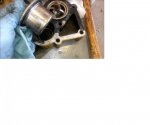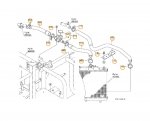Hello all
We have a Kubota RTV1140CPX S/N 18847 with the Kubota D1105-BJ engine.
We purchased this unit used.
I didn’t appear to have been abused and had 840 hrs on it.
We noted from the start that under load after about 45 min of operation the engine temp was approaching 235 by the electric gage.
I installed a direct reading gage that didn’t need electric. It reads the same.
We then had a genus use the machine and even after informing him that running in high brush causes the screen on the radiator to fill with debris and he had to stop and remove the cover and clean the screen. Well genus was too important to do a menial task.
So now I have replaced the cylinder head and all 3 pistons. All machine work performed by a very qualified machine shop. Connecting rods were twist and bend check etc.
I washed and back flushed the radiator.
I installed the radiator, a new thermostat and service the cooling system with 50/50 coolant.
I pre-oiled the engine using a suitable electric pump.
I bled the injection system while the electric pump was pumping oil and the glow plugs disconnected.
I connected the glow plugs and stated the engine with oil pressure on before cranking.
The engine started and ran like a Swiss watch.
I ran the engine at varying speeds in the shop until the cooling fan came on at about 180. The system cooled down and the fan shut off in short order.
Now my problem is the temp after about 45 min of running at 20 MPH gets up to very close to 230.
Removing the thermostat doesn’t change anything except the idle temperature. It only gets to about 140 after 30 to 45 min of idle time. The temp after running under load stayed the same about 230 when I stopped and let it idle after about a 10 min idle time the temp was down to 210.
My question is this normal and what is the max temp allowed for this engine installation?
Thanks in advance.
Phil P
We have a Kubota RTV1140CPX S/N 18847 with the Kubota D1105-BJ engine.
We purchased this unit used.
I didn’t appear to have been abused and had 840 hrs on it.
We noted from the start that under load after about 45 min of operation the engine temp was approaching 235 by the electric gage.
I installed a direct reading gage that didn’t need electric. It reads the same.
We then had a genus use the machine and even after informing him that running in high brush causes the screen on the radiator to fill with debris and he had to stop and remove the cover and clean the screen. Well genus was too important to do a menial task.
So now I have replaced the cylinder head and all 3 pistons. All machine work performed by a very qualified machine shop. Connecting rods were twist and bend check etc.
I washed and back flushed the radiator.
I installed the radiator, a new thermostat and service the cooling system with 50/50 coolant.
I pre-oiled the engine using a suitable electric pump.
I bled the injection system while the electric pump was pumping oil and the glow plugs disconnected.
I connected the glow plugs and stated the engine with oil pressure on before cranking.
The engine started and ran like a Swiss watch.
I ran the engine at varying speeds in the shop until the cooling fan came on at about 180. The system cooled down and the fan shut off in short order.
Now my problem is the temp after about 45 min of running at 20 MPH gets up to very close to 230.
Removing the thermostat doesn’t change anything except the idle temperature. It only gets to about 140 after 30 to 45 min of idle time. The temp after running under load stayed the same about 230 when I stopped and let it idle after about a 10 min idle time the temp was down to 210.
My question is this normal and what is the max temp allowed for this engine installation?
Thanks in advance.
Phil P



